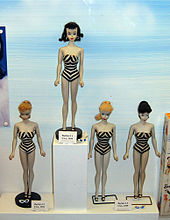 Fashion dolls are dolls primarily designed to be dressed to reflect fashion trends. They are manufactured both as toys for children to play with and as collectibles for adult collectors. The dolls are usually modeled after teen girls or adult women, though child, male, and even some non-human variants exist. Contemporary fashion dolls are typically made of vinyl or another plastic.
Fashion dolls are dolls primarily designed to be dressed to reflect fashion trends. They are manufactured both as toys for children to play with and as collectibles for adult collectors. The dolls are usually modeled after teen girls or adult women, though child, male, and even some non-human variants exist. Contemporary fashion dolls are typically made of vinyl or another plastic.
The earliest fashion dolls were French bisque dolls from the mid-19th  century. Barbie was released by the American toy-company Mattel in 1959, and was followed by many similar vinyl fashion dolls intended as children’s toys. The size of the Barbie, 11.5 inches (290 mm) set the standard often used by other manufacturers. But fashion dolls have been made in many different sizes varying from 10.5 inches (270 mm) to 36 inches (900 mm).
century. Barbie was released by the American toy-company Mattel in 1959, and was followed by many similar vinyl fashion dolls intended as children’s toys. The size of the Barbie, 11.5 inches (290 mm) set the standard often used by other manufacturers. But fashion dolls have been made in many different sizes varying from 10.5 inches (270 mm) to 36 inches (900 mm).
Costumers and seamstresses use fashion dolls as a canvas for their work. Customizers repaint faces, reroot hair, or do other alterations to the dolls themselves. Many of these works are one-of-a-kind. These artists are usually not connected to the original manufacturers and sell their work to collectors.
History and Types
The earliest bisque dolls from French companies were fashion dolls. These dominated the market between approximately 1860 and 1890.[1] They were made to represent grown up women and intended for children of affluent families to play with and dress in contemporary fashions.[1] These dolls came from companies like Jumeau, Bru, Gaultier, Rohmer, Simone and Huret, though their heads were often manufactured in Germany.[1] In the Passage Choiseul area of Paris an industry grew around making clothing and accessories for the dolls.[1] Child like bisque dolls appeared in the mid-19th century and overtook the market towards the end of the century.[1]
Barbie was launched by the American toy-company Mattel in 1959, inspired by the German Bild Lilli doll. Barbie has been an important part of the toy fashion doll market for fifty years.
Many fashion doll lines have been inspired by Barbie, or launched as alternatives to Barbie. Tammy was created by the Ideal Toy Company in 1962.[2] Advertised as “The Doll You Love to Dress”, Tammy was portrayed as a young American teenager, more “girl next door” than the cosmopolitan image of Barbie.[2] Sindy was created by the British Pedigree Dolls & Toys company in 1963 as a rival to Barbie with a wholesome look. In the late 1960s and early 1970s Ideal Toy Company released several larger fashion dolls with hair with adjustable length. The Crissy Doll and friends are 16″ and Velvet Doll and friends are 18″. British designer Mary Quant‘s Daisy doll from 1973 had a large selection of contemporary 70s fashion designed by Quant.
Fulla is marketed to children of Islamic and Middle-Eastern countries as an alternative to Barbie. The concept of her evolved around 1999, and she hit stores in late 2003.[3] Bratz were released in 2001, designed by Carter Bryant and manufactured by California toy company MGA Entertainment.[4] They are distinguished by large heads with skinny bodies and lush, glossy lips.[4] Mattel introduced the My Scene line in 2002 and the Flavas line in 2003 to rival Bratz.[5][6][7] In 2010 Mattel launched the Monster High doll line, based from fantasy and horror monsters. In 2014, artist Nickolai Lamm unveiled Lammily,[8] a fashion doll based on Lamm’s study comparing Barbie’s figure with measurements matching those of an average 19-year old woman.[9]
Asian fashion dolls are made by Asian manufacturers and primarily targeted to an Asian market. Blythe dolls with oversized heads and color changing eyes were originally made by American company Kenner but are now produced by Japanese company Takara. Another doll with an oversized head, Pullip, was created in 2003 in Korea. Japanese fashion dolls marketed to children include Licca (introduced in 1967) and Jenny (introduced in 1982) by Takara Tomy.
In the mid-1990s dolls like Gene Marshall from Ashton-Drake, Tyler Wentworth from Tonner and Alexandra Fairchild Ford from Madame Alexander appeared. They are between 15.5 and 16 inches (395 and 410 mm,) larger than other common fashion dolls. These dolls are mostly marketed to adult collectors.
Since we sell a lot of Fashion Dolls in our eBay Store Connectibles, we thought this article would be of interest to some of our customers.
This Post was taken from a Wikipedia Page and can be found with references HERE.
